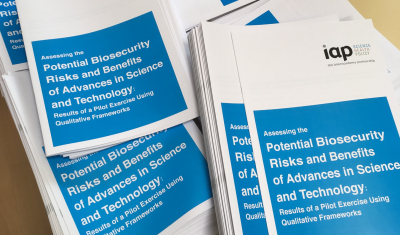


04 December 2019, Room 24, 08:50 AM
Understanding potential implications of advances in science and technology (S&T) for the operation of the Convention is a key task for the Biological Weapons Convention (BWC). It remains challenging because there is no commonly accepted method for assessing relevant potential risks. There is also no comparable framework to assess potential benefits and enable comparison of relative risks and benefits. Qualitative frameworks may be able to serve as tools to foster systematic discussions, reveal areas of agreement and disagreement, and provide a basis for continuing dialogue. They could be useful in a number of settings as part of the preparations for the 9th Review Conference in 20121.
The InterAcademy Partnership (IAP) and the US National Academies of Sciences, Engineering, and Medicine collaborated on a pilot excercise during the Meeting of Experts in August to examine how two qualitative frameworks developed to address biosecurity concerns could support transparent discussions of advances in S&T.[1] In a workshop on 1 August, a diverse international group of participants had the opportunity to apply these framweworks using BWC-relevant case examples. They discussed ways in which the frameworks could be adapted to help meet BWC goals, and began a discussion of how to develop a framework to address potential benefits of advances in S&T.
Join our side event on 04 December 2018 at the BWC Meeting of States Parties (Geneve, Switzerland) to learn more about the role of qualitative frameworks: we will release the summary report of the exercise and discuss the ways in which they could support the BWC (the summary report is also available at /node/51554).
Room 24
8:50 Breakfast Available
9:15 Welcome and Introduction to the Event
Chair: Jo Husbands, US National Academies
9:20 Assessing Risks and Benefits of Advances in the Life Sciences: The Potential Contribution of Qualitative Framework
Presentation: Jo Husbands, US National Academies
9:30 Facilitated Discussion with Participants in the Pilot Exercise
Moderator: Nancy Connell, Johns Hopkins Center for Health Security
9:45 General Discussion and Q&A
9:55 Adjourn
About the InterAcademy Partnership (IAP)
Under the umbrella of the InterAcademy Partnership (IAP), 140 national and regional member academies work together to support the vital role of science and its efforts to seek solutions to the world’s most challenging problems. IAP’s member academies are merit based and typically independent of government, allowing them to provide authoritative evidence to inform policy and decision-making. IAP member academies represent more than 30,000 of the world’s most respected scientific, medical and engineering leaders in over 100 countries across Africa, the Americas, AsiaPacific and Europe.
For more information see www.interacademies.org and follow @IAPartnership on Twitter.
About the US National Academies
The US National Academy of Sciences, National Academy of Engineering, and National Academy of Medicine are private, nonprofit institutions. Each Academy is an honorific, membership organization whose members are elected in recognition of outstanding achievements. The three organizations work together as the National Academies of Sciences, Engineering, and Medicine to provide expert advice on some of the most pressing challenges facing the nation and the world. Their work helps shape sound policies, inform public opinion, and advance the pursuit of science, engineering, and medicine. The National Academies also encourage education and research, recognize outstanding contributions to knowledge, and increase public understanding in matters of science, engineering, and medicine.
[1]National Academies of Science, Engineering, and Medicine (2018). Biodefense in the Age of Synthetic Biology. Washington, DC: National Academies Press (https://www.nap.edu/catalog/24890) and Jonathan B. Tucker (ed.) (2012). Innovation, Dual Use, and Security: Managing the Risks of Emerging Biological and Chemical Technologies. Cambridge, MA: The MIT Press.
